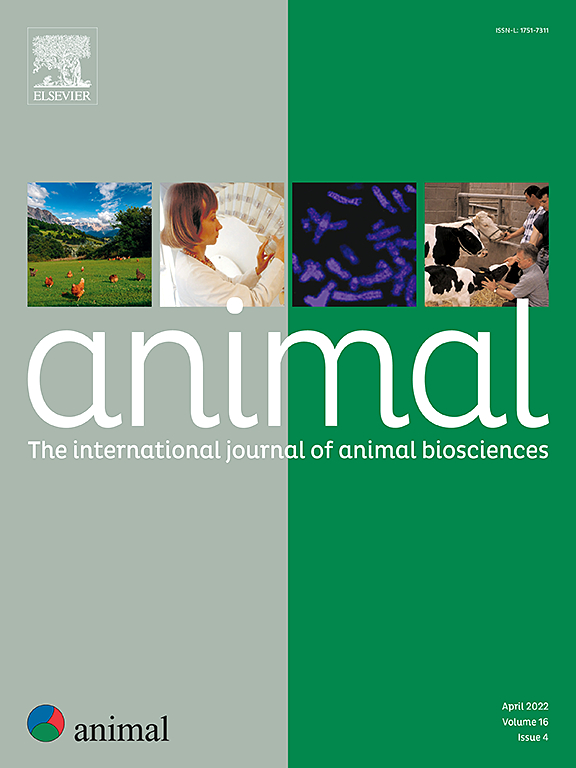Effect of replacing alfalfa hay with wheat silage on growth performance, nutrient digestibility, ruminal fermentation, and serum metabolites in feedlotting lambs
IF 4.2
2区 农林科学
Q1 AGRICULTURE, DAIRY & ANIMAL SCIENCE
引用次数: 0
Abstract
This study investigated the potential of using wheat silage (WS) as a partial or complete replacement for alfalfa hay (AH) in the diets of feedlotting lambs, addressing the global challenge of high feed costs and forage scarcity in livestock production. Wheat silage is widely cultivated across many regions, making it a practical and cost-effective alternative to alfalfa hay, particularly in areas where alfalfa is expensive or scarce. Sixty-four male small-tailed Chinese Han lambs with similar BWs (15.6 ± 0.41 kg) were selected and divided into four treatment diets according to the proportion of wheat silage replacing alfalfa hay:WS0 (WS: AH = 0: 100), WS36 (WS: AH = 36: 64), WS64 (WS: AH = 64: 36), and WS100 (WS: AH = 100: 0). Forage to concentrate ratios were fixed at (25:75) during Stage 1 (lambs aged 2–4 months) and (20:80) during Stage 2 (lambs aged 4–6 months). Results demonstrated that the digestibilities of ADF and NDF were greater (P < 0.01) in both WS36 and WS64 than in the WS100 group during Stage 1, and no significant differences were observed between the WS0 and WS100 groups. However, during Stage 2, the digestibility of both ADF and NDF was significantly lower in the WS100 group compared to the other three treatments. In terms of growth performance, the WS36 group had the greatest final BW in both stages. Ruminal pH and the molar propionate percentage decreased linearly with the increase of WS inclusion, while the molar acetate percentage and acetate: propionate ratio increased linearly with the increase of WS inclusion in both stages. However, the concentration of ammonia nitrogen, microbial CP, and total volatile fatty acids in the rumen showed a significant linear decrease in Stage 2. Among serum metabolism indexes, the insulin-like growth factor-1 decreased linearly (P < 0.01), while creatinine increased linearly with the increasing WS inclusion (P < 0.01). Meanwhile, serum total protein tends to decrease linearly in Stage 2 (P < 0.01). These findings highlight the international relevance of wheat silage as a sustainable forage alternative in intensive livestock systems worldwide. In summary, feeding a total mixed ration containing 36% wheat silage instead of alfalfa hay improved growth performance and nutrient digestibility, offering a viable solution for sustainable lamb production globally.
小麦青贮替代苜蓿干草对饲羔羊生长性能、营养物质消化率、瘤胃发酵和血清代谢物的影响
本研究探讨了用小麦青贮(WS)部分或完全替代饲喂羔羊饲粮中的苜蓿干草(AH)的潜力,以解决畜牧业生产中饲料成本高和饲料稀缺的全球挑战。小麦青贮在许多地区广泛种植,使其成为苜蓿干草的一种实用且具有成本效益的替代品,特别是在苜蓿昂贵或稀缺的地区。选用64只体重相近(15.6±0.41 kg)的中国小尾汉族公羊,按小麦青贮替代苜蓿干草的比例分为4种处理饲粮:WS0 (WS: AH = 0: 100)、WS36 (WS: AH = 36: 64)、WS64 (WS: AH = 64: 36)和WS100 (WS: AH = 100: 0)。第一阶段(2 - 4月龄)料精比固定为(25:75),第二阶段(4-6月龄)料精比固定为(20:80)。结果表明,ADF和NDF的消化率较高(P <;在第一阶段,WS36和WS64组与WS100组相比,差异均为0.01),而WS0和WS100组之间无显著差异。然而,在第2阶段,与其他3个处理相比,WS100组ADF和NDF的消化率均显著降低。在生长性能方面,WS36组在两个阶段的最终体重均最大。瘤胃pH和摩尔丙酸百分比随WS包裹体添加量的增加呈线性降低,而摩尔乙酸百分比和乙酸丙酸比随WS包裹体添加量的增加呈线性升高。瘤胃氨氮、微生物CP和总挥发性脂肪酸浓度在第2阶段呈显著的线性下降。血清代谢指标中,胰岛素样生长因子-1呈线性下降(P <;0.01),而肌酐随WS的增加呈线性增加(P <;0.01)。血清总蛋白在2期呈线性下降趋势(P <;0.01)。这些发现突出了小麦青贮作为全球集约化牲畜系统中可持续饲料替代品的国际相关性。综上所述,用含36%小麦青贮的混合日粮替代苜蓿干草,提高了生长性能和营养物质消化率,为全球羔羊可持续生产提供了可行的解决方案。
本文章由计算机程序翻译,如有差异,请以英文原文为准。
求助全文
约1分钟内获得全文
求助全文
来源期刊

Animal
农林科学-奶制品与动物科学
CiteScore
7.50
自引率
2.80%
发文量
246
审稿时长
3 months
期刊介绍:
Editorial board
animal attracts the best research in animal biology and animal systems from across the spectrum of the agricultural, biomedical, and environmental sciences. It is the central element in an exciting collaboration between the British Society of Animal Science (BSAS), Institut National de la Recherche Agronomique (INRA) and the European Federation of Animal Science (EAAP) and represents a merging of three scientific journals: Animal Science; Animal Research; Reproduction, Nutrition, Development. animal publishes original cutting-edge research, ''hot'' topics and horizon-scanning reviews on animal-related aspects of the life sciences at the molecular, cellular, organ, whole animal and production system levels. The main subject areas include: breeding and genetics; nutrition; physiology and functional biology of systems; behaviour, health and welfare; farming systems, environmental impact and climate change; product quality, human health and well-being. Animal models and papers dealing with the integration of research between these topics and their impact on the environment and people are particularly welcome.
 求助内容:
求助内容: 应助结果提醒方式:
应助结果提醒方式:


